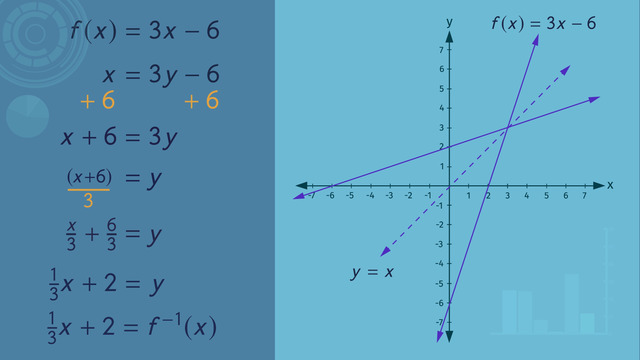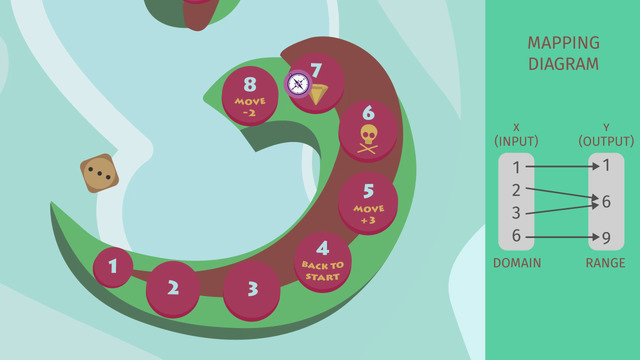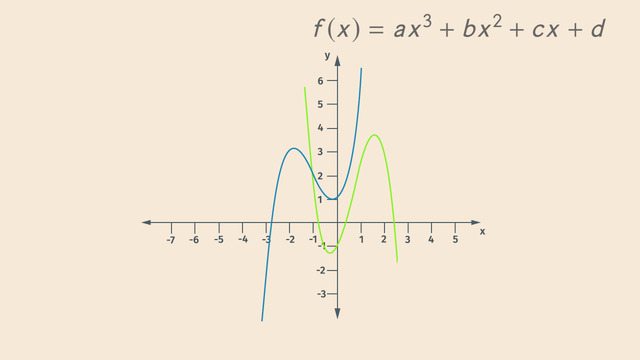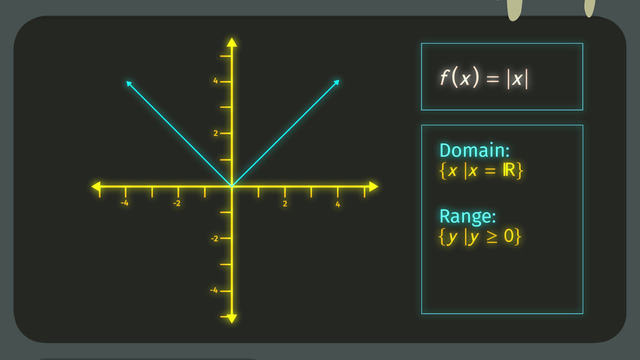Function Operations


Basics on the topic Function Operations
A function is a particular kind of relation between sets. A function takes every element x in a starting set, called the domain, and tells us how to assign it to exactly one element y in an ending set, called the range. Often functions are written in a form like f(x)=3x+5, where x is the element in the domain and 3x+5 gives the y which x is “sent to” in the range.
Functions can be combined using arithmetic operations which are similar to those used on polynomials: always combine like terms, remember the FOIL method, and don’t forget to simplify if the answer can be simplified! Here are some examples of performing operations with the functions f(x) = x² – 2x + 1 and g(x) = x – 1:
Add: f(x) + g(x)
(f + g)(x) = f(x) + g(x)
= (x² – 2x + 1) + (x – 1)
= x² – 2x + x + 1 – 1
= x² – x
Subtract: f(x) – g(x) (f – g)(x) = f(x) – g(x) = (x² – 2x + 1) – (x – 1) = x² – 2x – x + 1 + 1 = x² – 3x + 2
Multiply: f(x) ∙ g(x)
(f ∙ g)(x) = f(x) ∙ g(x)
= (x² – 2x + 1) (x + 1)
= x³ – 2x² + x² + x – 2x + 1
= x³ – x² – x + 1
Divide: f(x) ÷ g(x) (f ÷ g)(x) = f(x) ÷ g(x) = (x² – 2x + 1) ÷ (x – 1) = [(x – 1)(x – 1)] ÷ (x – 1) = x – 1
We need to perform operations on functions to calculate the change of temperature, compare production rates of companies, create phone apps, and so much more.
This lesson is also a prerequisite for studying composite functions.
Build a function that models a relationship between two quantities. CCSS.MATH.CONTENT.HSF.BF.A.1.B
Transcript Function Operations
Zooming along on his flying carpet, Jaanav heads for home. Oh geez, he’s caught in a sandstorm, again. As he’s covered with sand. He has sand in his hair, sand in his ears, it’s everywhere!
Back at home, he thinks, there must be a solution for this annoying problem. Eureka, Jaanav has an idea! He'll attach a sand-proof glass dome to his flying carpet and he can advertise this amazing new product onTV.
Expressing Costs in a Function
Of course, he wants to make lots and lots of money from this business venture, so he must figure out all the costs to manufacture and advertise the product. Plus, he must figure out the sales price of each item and and how many he must sell to make a healthy profit. Jaanav figures out that cost to make each carpet is 100 gold coins plus a one-time cost of 150 gold coins - to buy the loom used to weave the carpets. The total cost to produce the sand-proof glass dome is 50 gold coins per dome plus a one-time cost of 100 gold coins to buy the dome-building machinery. To figure out the total cost, let's write the costs of manufacturing as two different functions, and then add them together.
Let C represent the costs associated with the product, and let 'x' represent the number of units. We can write the costs of just the carpets that he will produce as C_carpet(x) = 100x + 150 and the costs of the sand-proof domes as C_dome(x) = 50x + 100. Remember, the costs depend on the number of items, 'x', that will be produced.
Adding Functions
To calculate the sum (f+g)(x), you just have to add f(x) and g(x). For the two given functions this means: (C_carpet + C_dome)(x) =C_carpet(x) + C_dome(x). Now to calculate the total cost of a flying carpet with a glass dome, Jaanav has to add the two functions together. C_totalcost(x) = C_carpet + C_dome(x). The sum of the two functions is equal to 100x + 150 + 50x + 100. Combine the like terms,
and then write the expression: 150x + 250.
Subtracting Functions
Now that Jaanav knows the production costs, he needs to consider the cost of the televison advertisement, and then figure out the selling price for each unit. The ad will cost a one-time fee of 750 gold coins. Based on all the cost information, he decides to sell the units for 250 gold coins each. We can write this information as the function, R(x). “R” represents the receipts after the cost of the advertisement. So, R(x) = 250x – 750.
How much money will be left over after paying all of the costs? This amount is the profit, and it's equal to the receipts minus the total cost. We can write this as the function P(x): P(x) = (R – C_totalcost)(x). Which equals (250x – 750) – (150x + 250). To simplify, don’t forget to distribute the negative across both terms inside the second set of parentheses. We can write the expression as 250x – 150x -750 – 250, and then combine the like terms, giving us P(x) = 100x -1000.
Break-Even / Covering the Cost
How many carpets does Jaanav need to sell just to break-even? Break-even is the amount of money Jaanav needs to earn just to cover his fixed costs. This is getting complicated! Maybe Jaanav should call his accountant? NO, we can help him. To determine the break even amount of this business venture we just need to solve the equation that models his profit. If we set P(x) = 0, then we can isolate 'x' and find out how many carpets Jaanav should sell. He needs to sell 10 domed carpets just to break even. Well done.
Multiplying Functions
But can we multiply two functions? To calculate the product of the functions (f times g)(x), simply multiply f(x) and g(x). Let's take a look at an example. f(x) equals 2x + 3 and g(x) equals 4x - 2. So to find the product (f times g)(x) we have to multiply the two terms 2x + 3 and 4x - 2. For example, using the FOIL-method we get: 8x² - 4x + 12x -6. We can simplify this expression by combining like terms. That's it.
Dividing Functions
And how do we divide two functions? Let's take a look. Just like multiplying two functions, you have to divide both terms - '3x+5' and 'x-2' - to get a new function - (f/g)(x). Oh, oh! The commercial is on the television! Let’s watch Do you get dust in your eyes when flying around on your magic carpet? Do you need protection from the elements? Then you need the OCD2000! The Oriental Carpet Dome will protect you from anything Mother Nature has to throw at you except maybe hurricanes and tornados...
Function Operations exercise
-
Determine the total cost of the sand-proof glass carpet dome.
HintsFor example, if the production of one carpet dome costs $10$ dollars, with a one-time cost of $200$ dollars, then the total cost of producing $x$ carpets is $C_{\text{carpet}}(x)=10x+200$.
To add functions together, just add the terms of both functions together:
SolutionThe cost to make each carpet is 100 gold coins plus a one-time cost of 150 gold coins - to buy the loom used to weave the carpets.
The total cost to produce the sand-proof glass dome is 50 gold coins per dome plus a one-time cost of 100 gold coins to buy the dome-building machinery.
To figure out the total cost, let's write the costs of manufacturing as two different functions, and then add them together.
Let $x$ represent the number of carpets produced and $C_{\text{carpet}}(x)$ represent the total cost of producing $x$ carpets. We then have that: $C_{\text{carpet}}(x)=100x+150$.
Let $x$ represent the number of domes produced and $C_{\text{dome}}(x)$ represent the total cost of producing $x$ domes. We then have that: $C_{\text{dome}}(x)=50x+100$.
If Jaanav produces $x$ carpets and domes, then we just have to add the total costs of the domes and the carpets together to get the total cost $C_{\text{total cost}}(x)$ of the sand-proof glass carpet dome!
i.e. $C_{\text{total cost}}(x)=C_{\text{carpet}}(x)+C_{\text{dome}}(x)$.
Specifically, $C_{\text{total cost}}(x)=100x+150+50x+100$. Combining like terms, we get $C_{\text{total cost}}(x)=150x+250$.
-
Establish the equation to calculate Jaanav total profit.
HintsThe $750$ gold coins is a cost which needs to be paid from the money made from the carpet domes. So you have to subtract $750$ from the amount of money made.
If one carpet dome costs $10$ dollars, then we get $10\times 10=100$ dollars for selling $10$ carpet domes.
An example of combining like terms:
$20x+30-15x=20x-15x+30=5x+30$
SolutionLet $x$ be the number of carpet domes Jaanav would like to sell and $C_{\text{initial profit}}(x)$ be the amount of gold coins Jaanav makes after covering the cost for his commercial. We then have that
$C_{\text{initial profit}}(x)=250x-750$.
To get the total profit $C_{\text{total profit}}(x)$ after selling $x$ carpet domes, we have to subtract the total cost from the initial profit:
$C_{\text{total profit}}(x)=C_{\text{initial profit}}(x)-C_{\text{total cost}}(x)$.
We can then conclude that the total profit is
$C_{\text{total profit}}(x)=250x-750-(150x+250)=100x-1000$.
-
Examine the total cost of the production with Janaav's brother's new glass dome machine.
HintsRemember to combine like terms.
To add terms with variables you just have to add the coefficients:
SolutionThe total cost is the sum of the carpet cost and the dome cost.
We have that the carpet cost is given by, $C_{\text{carpets}}(x)=100 x+ 150$, and that the dome cost is given by, $C_{\text{dome}}(x)=30x+150$.
The sum of these functions gives us the total cost:
$C_{\text{total cost}}(x)=(C_{\text{carpets}}+C_{\text{dome}})(x)=(100 x+ 150)+(30x+150)=100 x+ 150+30x+150$.
Now we rearrange the terms so that the like terms are together,
$C_{\text{total cost}}(x)=100x+30x+150+150$.
And we combine like terms to get,
$C_{\text{total cost}}(x)=130x+300$.
-
Figure out the price for one dome.
HintsThe cost function is given by the item cost multiplied by the number of domes produced plus any one-time costs.
The price which Janaav will break even at will give a profit of zero gold coins.
You have to solve a linear equation with an unknown price $y$.
SolutionThe break even point is when the amount of money made and the costs are the same.
i.e. the total profit is zero.
The function representing the costs is
$C(x)=80x+200$,
where the cost for advertising is included.
Because the amount of money made for one dome is unknown, we represent it with the variable $y$. So we get the profit function,
$P(x)=yx-(80x+200)$.
We know that for $x=10$ the costs should be totally covered, that means that we want $P(10)=0$. This gives us the following equation with the unknown price $y$:
$0=10y-(80(10)+200)$.
We simplify the term inside the parentheses to $C(10)=80(10)+200=1000$ and solve the equation as follows:
$\begin{array}{rcr} 0&=&10y-1000\\ +1000&&+1000\\ 1000&=&10y\\ \overline{\color{#669900}{\div 10}}&&\overline{\color{#669900}{\div 10}}\\ 100&=&y \end{array}$
We then find that Janaav should charge 100 gold coins per dome.
-
Decide what the correct rules are for combining functions.
HintsAn example of addition with $f(x)=2x+1$ and $g(x)=3x-2$:
An example for division with $f(x)=2x+1$ and $g(x)=3x-2$:
An example for multiplication with $f(x)=2x+1$ and $g(x)=3x-2$:
SolutionHow can we add, subtract, multiply, or divide two functions?
- $(f+g)(x)=f(x)+g(x)$
- $(f-g)(x)=f(x)-g(x)$
- $(f\times g)(x)=f(x)\times g(x)$
- $(f\div g)(x)=f(x)\div g(x)$
For example, with $f(x)=2x+1$ and $g(x)=3x-2$:
$(f-g)(x)=f(x)-g(x)=2x+1-(3x-2)=2x+1-3x+2=-x+3$.
-
Calculate each operation with the given functions.
HintsRemember to keep track of signs.
Use the FOIL method for multiplying two binomials:
- Multiply the First.
- Next multiply the Outer.
- Then the Inner.
- Last multiply the Last.
SolutionTo add, subtract, multiply, or divide functions, just add, subtract, multiply, or divide their terms:
- $(f+g)(x)=f(x)+g(x)=12x+23+4x-3=12x+4x+23-3=16x+20$.
- $(f-h)(x)=f(x)-h(x)=12x+23-(12x-9)=12x+23-12x+9=32$.
- $(h\div g)(x)=\frac{h(x)}{g(x)}=\frac{12x-9}{4x-3}=\frac{3(4x-3)}{4x-3}=3$.
- $(f\times h)(x)=f(x)\times h(x)=(12x+23)\times (4x-3)=48x^2+56x-69$.


















very fun, the sand storm was hilarious
Thanks for liking (and commenting) on our videos!
Very informative for math AND advertising! Thanks!